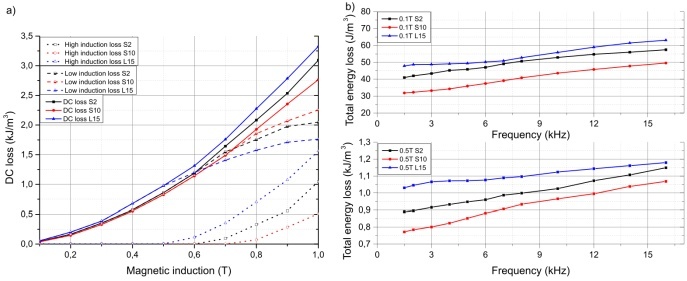Speaker
Description
Soft magnetic composites (SMCs) are in general ferromagnetic powder particles surrounded by electroinsulating layer [1]. In this work we examined magnetic properties and magnetization processes in Fe-based soft magnetic composites with Al$_2$O$_3$ electroinsulating layer created by mechanofusion process. Mechanofusion (also called dry coating) is process which attaches small particles (Al$_2$O$_3$ powder, 1-40 $\mu$m) on larger particles (Fe powder, 125-200 $\mu$m) without the use of any binders and solvents [2]. Two series of four ring samples with rectangular cross-section were created, based on mechanofusion time and the amount of the Al$_2$O$_3$ powder in powder mixture. The names of the samples were chosen as follows: the letter indicates the time of mechanofusion (S means short (15 minutes) and L means long (30 minutes)) and the number indicates the weight percentage of Al$_2$O$_3$ used in mixture with Fe powder. We examined electrical resistivity, coercivity, complex permeability and AC and DC losses. The DC loss separation according to Landgraf´s approach was executed [3].

Fig. 1 DC loss and DC loss separation according to Landgraf´s approach (a) and AC loss (b).
We found that, the optimal Al$_2$O$_3$ content for shorter mechanofusion process duration is around 5-10 $\%$, because of the lowest loss and the highest permeability. Longer mechanofusion process with increasing of Al$_2$O$_3$ content leads to deterioration of the magnetic properties of SMCs.
Acknowledgements
This work was realized within the frame of the project “FUCO” financed by Slovak Research and Development Agency under the contract APVV-20-0072 and by Scientific Grant Agency of Ministry of Education of Slovak Republic and Slovak Academy of Sciences – projects VEGA 1/0016/24 and 1/0132/24.
References
[1] H. Shokrollahi and K. Janghorban, “Soft magnetic composite materials (SMCs),” Journal of Materials Processing Technology, vol. 189, no. 1–3. Elsevier BV, pp. 1–12, Jul. 2007. doi: 10.1016/j.jmatprotec.2007.02.034.
[2] F. Jay, V. Gauthier, and S. Dubois, “Iron Particles Coated with Alumina: Synthesis by a Mechanofusion Process and Study of the High‐Temperature Oxidation Resistance,” Journal of the American Ceramic Society, vol. 89, no. 11. Wiley, pp. 3522–3528, Sep. 12, 2006. doi: 10.1111/j.1551-2916.2006.01266.x.
[3] F. J. G. Landgraf, J. C. Teixeira, M. Emura, M. F. de Campos, and C. S. Muranaka, “Separating Components of the Hysteresis Loss of Non-Oriented Electrical Steels,” Materials Science Forum, vol. 302–303. Trans Tech Publications, Ltd., pp. 440–445, Jan. 1999. doi: 10.4028/www.scientific.net/msf.302-303.440.

